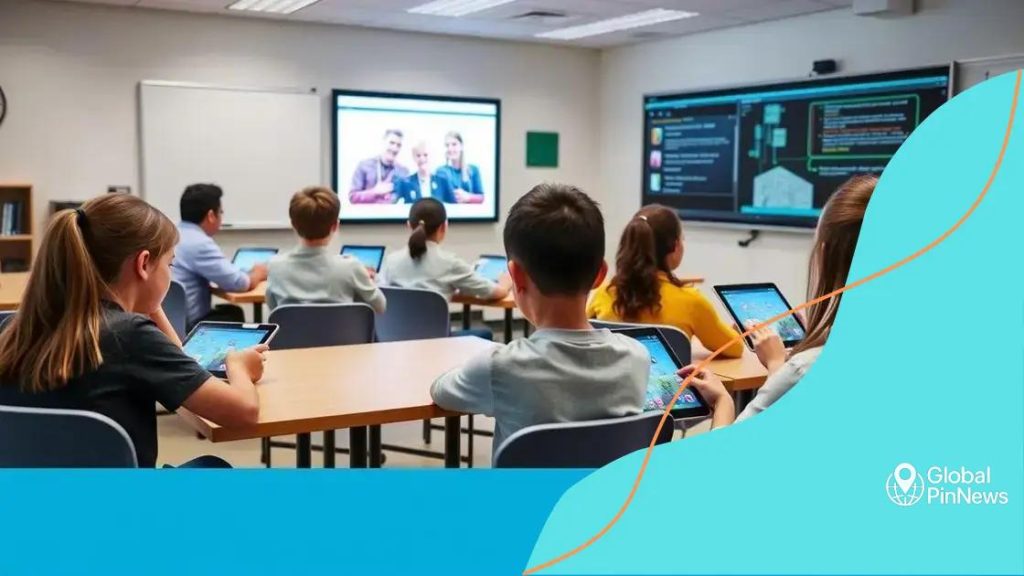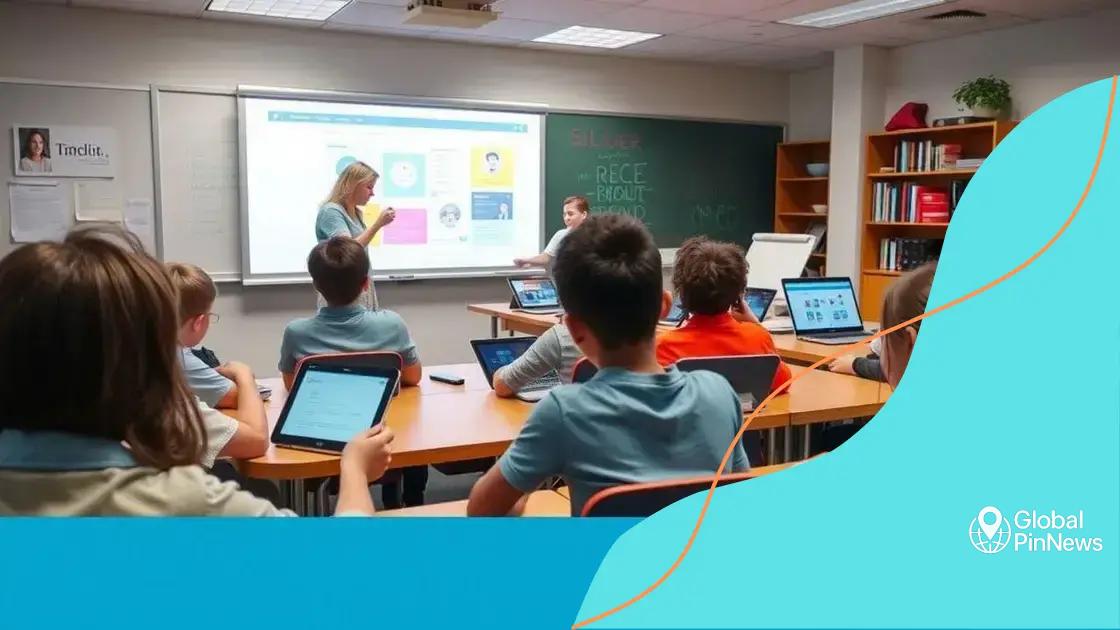Integration of new technologies in education can transform learning

The integration of new technologies in education enhances student engagement, facilitates personalized learning experiences, and equips learners with essential skills for the future.
Integration of new technologies in education is reshaping how students learn and interact. Imagine classrooms where tech enhances engagement, creating opportunities for students to thrive. Curious about how these changes unfold? Let’s dive in.
Understanding the role of technology in education
Technology plays a crucial role in modern education. Understanding this role helps us see how classrooms are changing. With devices and online resources, learning has become more interactive and engaging.
The Impact of Technology
When technology is integrated into education, it enhances the learning experience. Students can access information quickly and collaborate with peers effortlessly.
Key Benefits of Technology in Education
- Increased Engagement: Interactive lessons keep students interested.
- Access to Resources: Students can find vast amounts of information online.
- Personalized Learning: Technology allows tailored educational experiences for each student.
Through technology, students can connect with experts worldwide. This opens doors to new ideas and perspectives. For example, virtual field trips let students explore places they might never visit physically.
Furthermore, the use of educational software and apps supports different learning styles. Whether visual, auditory, or kinesthetic, there are tools to aid every student. The shift towards technology also prepares them for future jobs that require tech-savvy skills.
Challenges of Technology Integration
Despite the benefits, there are challenges to consider. Not all students have equal access to technology, leading to disparities in learning opportunities. Teachers also need training to effectively incorporate technology into their teaching.
In summary, understanding the role of technology in education illuminates its importance. It has the potential to greatly enhance learning, but we must address the challenges it presents.
Benefits of integrating technology in classrooms
Integrating technology in classrooms brings many benefits. These advantages help students learn better and prepare them for the future.
Enhancing Learning Experiences
Technology makes learning more engaging. With tools like interactive whiteboards and educational software, lessons become dynamic. Students can visualize concepts clearly, making it easier to understand.
Collaboration and Communication
When technology is used, students can work together from different locations. They can share ideas quickly through online platforms.
- Group Projects: Use tools like Google Docs for real-time collaboration.
- Communication: Chat functions allow instant feedback.
- Online Forums: Students can discuss topics beyond the classroom.
Such collaboration fosters teamwork and develops vital skills needed in the workforce.
Personalized Learning
Technology allows for personalized learning experiences. Every student can learn at their own pace. With educational apps and platforms, students receive tailored resources based on their specific needs. This approach respects individual learning styles, ensuring that everyone has the opportunity to succeed.
Additionally, students can revisit materials as needed. This flexibility helps reinforce learning. Moreover, teachers can track progress easily, allowing them to provide support where necessary.
Access to Resources
Technology opens doors to a wealth of resources. Students can access online libraries, databases, and research tools. With just a click, they can explore a world of information.
This access encourages students to ask questions and dive deeper into subjects. They become more curious and motivated to learn independently.
Effective tools for tech integration

When discussing effective tools for tech integration, it’s essential to recognize how these resources enhance learning experiences. Various technologies can help teachers implement innovative methods in classrooms.
Learning Management Systems (LMS)
A Learning Management System is vital for organizing coursework. Platforms like Google Classroom and Moodle allow teachers to share materials, assignments, and feedback efficiently. With an LMS, communication between students and teachers becomes seamless.
Interactive Whiteboards
Interactive whiteboards bring lessons to life. These boards engage students through multimedia presentations. By incorporating videos, images, and interactive activities, learning becomes more dynamic.
Educational Apps
Many educational apps cater to different subjects and skills. These applications help personalize learning experiences.
- Kahoot!: A fun quiz platform to encourage participation.
- Nearpod: Offers interactive lessons that students can enjoy on their devices.
- Quizlet: Helps students learn through flashcards and games.
Through these apps, students can practice at their own pace, reinforcing their understanding of material.
Collaboration Tools
Tools like Slack or Microsoft Teams allow for easy collaboration among students. They can quickly share ideas and feedback on group projects, enhancing teamwork and communication skills.
Using these tools encourages students to participate actively and develop essential skills they will need in their future careers.
Integrating technology effectively in classrooms empowers students and teachers by opening new opportunities for learning. With the right tools, education becomes more personalized, engaging, and accessible.
Challenges faced by educators
Integrating technology in education presents several challenges for educators. Identifying these obstacles is crucial for effective implementation. One major challenge is the need for proper training and support.
Training and Professional Development
Many teachers feel unprepared to use new technologies. Training programs must be available to help them integrate these tools effectively. Without adequate support, they may not use technology to its full potential.
Access to Resources
An essential requirement for tech integration is access to resources. Not all schools have the budget for the latest devices and software. This creates an uneven playing field where some students have better opportunities than others.
- Funding Issues: Limited budgets can hinder technology purchases.
- Internet Connectivity: Some areas suffer from poor connectivity, making online resources hard to access.
- Device Availability: Not all students have personal devices to use for schoolwork.
Educators must navigate these barriers to ensure all students can benefit from technology.
Time Constraints
Another challenge educators face is time. Finding the time to plan lessons that incorporate technology can be difficult. Teachers already have many responsibilities. They need time to learn how to use new tools and develop effective lesson plans.
Additionally, integrating technology requires ongoing evaluation and adaptation. This process can be time-consuming but is vital for success.
Finally, balancing traditional teaching methods with new technology can be tricky. Some educators may be reluctant to abandon their familiar practices. Overcoming these challenges is crucial for the successful integration of technology in education.
Future trends in educational technology
The field of educational technology is rapidly evolving. Future trends are exciting and hold great potential to enhance the learning experience for students around the world. One significant trend is the rise of artificial intelligence (AI) in education.
Artificial Intelligence in Education
AI can personalize learning by adapting to each student’s needs. By analyzing data, AI tools can recommend resources and tailor lessons to fit individual learning styles. This means that every student can progress at their own pace, making learning more effective.
Virtual and Augmented Reality
Another exciting trend is the use of virtual reality (VR) and augmented reality (AR) in classrooms. These technologies allow students to immerse themselves in different environments. For example, they can take virtual field trips to historical sites or explore complex scientific concepts in 3D.
- Enhanced Engagement: VR and AR can make learning more interactive and engaging.
- Real-World Experience: Students can experience scenarios they wouldn’t normally encounter.
- Improved Understanding: Complex subjects become easier to grasp through immersive experiences.
As technology advances, the integration of VR and AR will likely become more common in educational settings.
Gamification of Learning
Gamification is another trend that captures students’ attention. By incorporating game elements into lessons, educators can motivate students to learn. This technique encourages participation and makes learning fun.
Students often enjoy competing in friendly challenges and earning rewards for their achievements. Gamification can lead to improved retention of information and a greater enthusiasm for learning.
Increased Focus on Data Analytics
Lastly, data analytics will play a crucial role in the future of education. Educators will be able to track student progress more effectively using analytical tools. This data enables targeted interventions and lets teachers adapt their teaching strategies based on student performance.
As we look to the future, these trends in educational technology promise to create more engaging, personalized, and effective learning environments. Educators and students alike will benefit from these advancements, making education more accessible and enjoyable.
In conclusion, the integration of new technologies in education offers numerous benefits, transforming how students learn and engage. As we embrace tools like AI, virtual reality, and gamification, we pave the way for personalized learning experiences. However, challenges like access to resources and teacher training must be addressed to make this vision a reality. Looking ahead, the future trends in educational technology promise to create even more innovative and effective learning environments.
FAQ – Frequently Asked Questions about the Integration of Technology in Education
What are the main benefits of integrating technology in classrooms?
Integrating technology enhances student engagement, enables personalized learning, and provides access to a wealth of resources, making learning more interactive.
How does artificial intelligence personalize learning?
AI analyzes student data to tailor educational content to individual needs, helping each student learn at their own pace.
What obstacles do educators face when using technology?
Challenges include insufficient training, lack of resources, time constraints, and reluctance to change traditional teaching methods.
What is gamification and how does it benefit learning?
Gamification incorporates game elements into lessons, motivating students to engage actively and making learning fun and effective.
